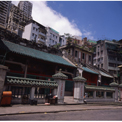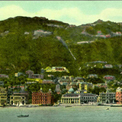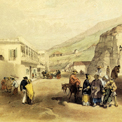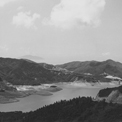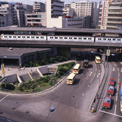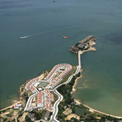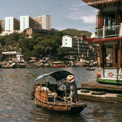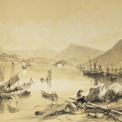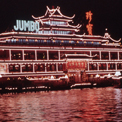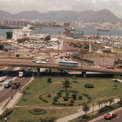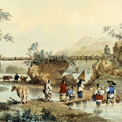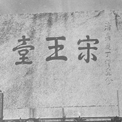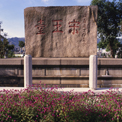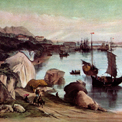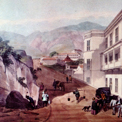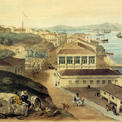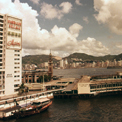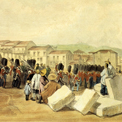Entrance of Tsing Shan Monastery, Tuen Mun
The Shanmen, the main entrance to the monastery, pronounces like “Sanmen” [Three Gates] in Chinese, is symbolizing San Jietuo Men [Three Gates to Deliverance]. Built in 1918, it is significant in that it carries on religion and culture through decorations and inscriptions. For example, the ridge is engraved with Sanskrit at the front and back, while the steles bear Chinese characters and couplets.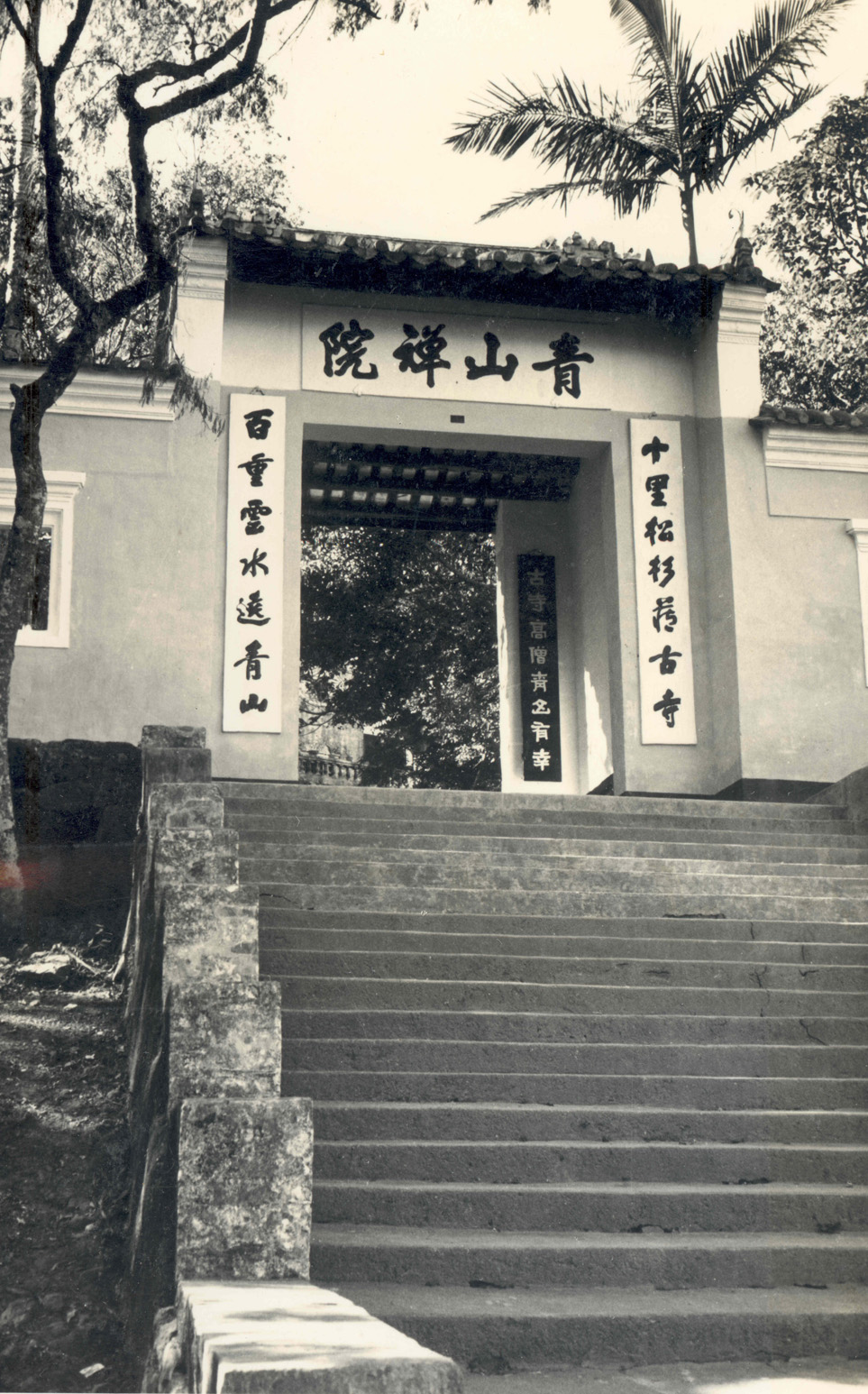
| Date | c.1950s |
| Place | New Territories/Tuen Mun District/Tuen Mun/(Street)/Tsing Shan Monastery |
| Material Type | Image |
| Collection | Hong Kong Places |
| Source | Courtesy of The University of Hong Kong Libraries |
| Repository | The University of Hong Kong Libraries |
| Accession No. | D2008.0053 |
Entrance of Tsing Shan Monastery, Tuen Mun
The Shanmen, the main entrance to the monastery, pronounces like “Sanmen” [Three Gates] in Chinese, is symbolizing San Jietuo Men [Three Gates to Deliverance]. Built in 1918, it is significant in that it carries on religion and culture through decorations and inscriptions. For example, the ridge is engraved with Sanskrit at the front and back, while the steles bear Chinese characters and couplets.
| Date | c.1950s |
| Place | New Territories/Tuen Mun District/Tuen Mun/(Street)/Tsing Shan Monastery |
| Material Type | Image |
| Collection | Hong Kong Places |
| Source | Courtesy of The University of Hong Kong Libraries |
| Repository | The University of Hong Kong Libraries |
| Accession No. | D2008.0053 |
Entrance of Tsing Shan Monastery, Tuen Mun
The Shanmen, the main entrance to the monastery, pronounces like “Sanmen” [Three Gates] in Chinese, is symbolizing San Jietuo Men [Three Gates to Deliverance]. Built in 1918, it is significant in that it carries on religion and culture through decorations and inscriptions. For example, the ridge is engraved with Sanskrit at the front and back, while the steles bear Chinese characters and couplets.
| Date | c.1950s |
| Place | New Territories/Tuen Mun District/Tuen Mun/(Street)/Tsing Shan Monastery |
| Material Type | Image |
| Collection | Hong Kong Places |
| Source | Courtesy of The University of Hong Kong Libraries |
| Repository | The University of Hong Kong Libraries |
| Accession No. | D2008.0053 |
Entrance of Tsing Shan Monastery, Tuen Mun
The Shanmen, the main entrance to the monastery, pronounces like “Sanmen” [Three Gates] in Chinese, is symbolizing San Jietuo Men [Three Gates to Deliverance]. Built in 1918, it is significant in that it carries on religion and culture through decorations and inscriptions. For example, the ridge is engraved with Sanskrit at the front and back, while the steles bear Chinese characters and couplets.
| Date | c.1950s |
| Place | New Territories/Tuen Mun District/Tuen Mun/(Street)/Tsing Shan Monastery |
| Material Type | Image |
| Collection | Hong Kong Places |
| Source | Courtesy of The University of Hong Kong Libraries |
| Repository | The University of Hong Kong Libraries |
| Accession No. | D2008.0053 |
Entrance of Tsing Shan Monastery, Tuen Mun
The Shanmen, the main entrance to the monastery, pronounces like “Sanmen” [Three Gates] in Chinese, is symbolizing San Jietuo Men [Three Gates to Deliverance]. Built in 1918, it is significant in that it carries on religion and culture through decorations and inscriptions. For example, the ridge is engraved with Sanskrit at the front and back, while the steles bear Chinese characters and couplets.
| Date | c.1950s |
| Material Type | Image |
| Collection | Hong Kong Places |
| Source | Courtesy of The University of Hong Kong Libraries |
| Repository | The University of Hong Kong Libraries |
| Accession No. | D2008.0053 |
Entrance of Tsing Shan Monastery, Tuen Mun
The Shanmen, the main entrance to the monastery, pronounces like “Sanmen” [Three Gates] in Chinese, is symbolizing San Jietuo Men [Three Gates to Deliverance]. Built in 1918, it is significant in that it carries on religion and culture through decorations and inscriptions. For example, the ridge is engraved with Sanskrit at the front and back, while the steles bear Chinese characters and couplets.
| Date | c.1950s |
| Place | New Territories/Tuen Mun District/Tuen Mun/(Street)/Tsing Shan Monastery |
| Material Type | Image |
| Collection | Hong Kong Places |
| Source | Courtesy of The University of Hong Kong Libraries |
| Repository | The University of Hong Kong Libraries |
| Accession No. | D2008.0053 |
Entrance of Tsing Shan Monastery, Tuen Mun
The Shanmen, the main entrance to the monastery, pronounces like “Sanmen” [Three Gates] in Chinese, is symbolizing San Jietuo Men [Three Gates to Deliverance]. Built in 1918, it is significant in that it carries on religion and culture through decorations and inscriptions. For example, the ridge is engraved with Sanskrit at the front and back, while the steles bear Chinese characters and couplets.
| Date | c.1950s |
| Place | New Territories/Tuen Mun District/Tuen Mun/(Street)/Tsing Shan Monastery |
| Material Type | Image |
| Collection | Hong Kong Places |
| Source | Courtesy of The University of Hong Kong Libraries |
| Repository | The University of Hong Kong Libraries |
| Accession No. | D2008.0053 |
Entrance of Tsing Shan Monastery, Tuen Mun
The Shanmen, the main entrance to the monastery, pronounces like “Sanmen” [Three Gates] in Chinese, is symbolizing San Jietuo Men [Three Gates to Deliverance]. Built in 1918, it is significant in that it carries on religion and culture through decorations and inscriptions. For example, the ridge is engraved with Sanskrit at the front and back, while the steles bear Chinese characters and couplets.
| Date of Death | c.1950s |
| Place | New Territories/Tuen Mun District/Tuen Mun/(Street)/Tsing Shan Monastery |
| Material Type | Image |
| Collection | Hong Kong Places |
| Source | Courtesy of The University of Hong Kong Libraries |
| Repository | The University of Hong Kong Libraries |
| Accession No. | D2008.0053 |
Entrance of Tsing Shan Monastery, Tuen Mun
The Shanmen, the main entrance to the monastery, pronounces like “Sanmen” [Three Gates] in Chinese, is symbolizing San Jietuo Men [Three Gates to Deliverance]. Built in 1918, it is significant in that it carries on religion and culture through decorations and inscriptions. For example, the ridge is engraved with Sanskrit at the front and back, while the steles bear Chinese characters and couplets.
| Date | c.1950s |
| Material Type | Image |
| Collection | Hong Kong Places |
| Source | Courtesy of The University of Hong Kong Libraries |
| Accession No. | D2008.0053 |
Entrance of Tsing Shan Monastery, Tuen Mun
The Shanmen, the main entrance to the monastery, pronounces like “Sanmen” [Three Gates] in Chinese, is symbolizing San Jietuo Men [Three Gates to Deliverance]. Built in 1918, it is significant in that it carries on religion and culture through decorations and inscriptions. For example, the ridge is engraved with Sanskrit at the front and back, while the steles bear Chinese characters and couplets.
| Date | c.1950s |
| Material Type | Image |
| Place | New Territories/Tuen Mun District/Tuen Mun/(Street)/Tsing Shan Monastery |
| Collection | Hong Kong Places |
| Source | Courtesy of The University of Hong Kong Libraries |
| Repository | The University of Hong Kong Libraries |
| Accession No. | D2008.0053 |
Entrance of Tsing Shan Monastery, Tuen Mun
The Shanmen, the main entrance to the monastery, pronounces like “Sanmen” [Three Gates] in Chinese, is symbolizing San Jietuo Men [Three Gates to Deliverance]. Built in 1918, it is significant in that it carries on religion and culture through decorations and inscriptions. For example, the ridge is engraved with Sanskrit at the front and back, while the steles bear Chinese characters and couplets.
| Date | c.1950s |
| Place | New Territories/Tuen Mun District/Tuen Mun/(Street)/Tsing Shan Monastery |
| Material Type | Image |
| Collection | Hong Kong Places |
| Source | Courtesy of The University of Hong Kong Libraries |
| Repository | The University of Hong Kong Libraries |
| Accession No. | D2008.0053 |
Entrance of Tsing Shan Monastery, Tuen Mun
The Shanmen, the main entrance to the monastery, pronounces like “Sanmen” [Three Gates] in Chinese, is symbolizing San Jietuo Men [Three Gates to Deliverance]. Built in 1918, it is significant in that it carries on religion and culture through decorations and inscriptions. For example, the ridge is engraved with Sanskrit at the front and back, while the steles bear Chinese characters and couplets.
| Date | c.1950s |
| Place | New Territories/Tuen Mun District/Tuen Mun/(Street)/Tsing Shan Monastery |
| Material Type | Image |
| Collection | Hong Kong Places |
| Source | Courtesy of The University of Hong Kong Libraries |
| Repository | The University of Hong Kong Libraries |
| Accession No. | D2008.0053 |
Entrance of Tsing Shan Monastery, Tuen Mun
The Shanmen, the main entrance to the monastery, pronounces like “Sanmen” [Three Gates] in Chinese, is symbolizing San Jietuo Men [Three Gates to Deliverance]. Built in 1918, it is significant in that it carries on religion and culture through decorations and inscriptions. For example, the ridge is engraved with Sanskrit at the front and back, while the steles bear Chinese characters and couplets.
| Date | c.1950s |
| Place | New Territories/Tuen Mun District/Tuen Mun/(Street)/Tsing Shan Monastery |
| Material Type | Image |
| Collection | Hong Kong Places |
| Source | Courtesy of The University of Hong Kong Libraries |
| Repository | The University of Hong Kong Libraries |
| Accession No. | D2008.0053 |
Copyright © 2012 Hong Kong Memory



